+ Open data
Open data
- Basic information
Basic information
| Entry | Database: PDB / ID: 6l35 | ||||||||||||||||||||||||||||||
|---|---|---|---|---|---|---|---|---|---|---|---|---|---|---|---|---|---|---|---|---|---|---|---|---|---|---|---|---|---|---|---|
| Title | PSI-LHCI Supercomplex from Physcometrella patens | ||||||||||||||||||||||||||||||
 Components Components |
| ||||||||||||||||||||||||||||||
 Keywords Keywords | STRUCTURAL PROTEIN / Cryo-EM / PSI-LHCI / Physcomitrella patens | ||||||||||||||||||||||||||||||
| Function / homology |  Function and homology information Function and homology informationphotosystem I antenna complex / response to low light intensity stimulus / pigment binding / response to high light intensity / photosynthesis, light harvesting in photosystem I / photosynthesis, light harvesting / chloroplast thylakoid lumen / photosystem I reaction center / photosystem I / photosynthetic electron transport in photosystem I ...photosystem I antenna complex / response to low light intensity stimulus / pigment binding / response to high light intensity / photosynthesis, light harvesting in photosystem I / photosynthesis, light harvesting / chloroplast thylakoid lumen / photosystem I reaction center / photosystem I / photosynthetic electron transport in photosystem I / photosystem I / photosystem II / chlorophyll binding / chloroplast thylakoid membrane / response to light stimulus / membrane => GO:0016020 / photosynthesis / response to cold / chloroplast / 4 iron, 4 sulfur cluster binding / oxidoreductase activity / electron transfer activity / serine-type endopeptidase activity / magnesium ion binding / protein homodimerization activity / metal ion binding Similarity search - Function | ||||||||||||||||||||||||||||||
| Biological species |  Physcomitrium patens (plant) Physcomitrium patens (plant) | ||||||||||||||||||||||||||||||
| Method | ELECTRON MICROSCOPY / single particle reconstruction / Resolution: 3.23 Å | ||||||||||||||||||||||||||||||
 Authors Authors | Zhao, L. / Yan, Q.J. / Qin, X.C. | ||||||||||||||||||||||||||||||
 Citation Citation |  Journal: Cell Discov / Year: 2021 Journal: Cell Discov / Year: 2021Title: Antenna arrangement and energy-transfer pathways of PSI-LHCI from the moss Physcomitrella patens. Authors: Qiujing Yan / Liang Zhao / Wenda Wang / Xiong Pi / Guangye Han / Jie Wang / Lingpeng Cheng / Yi-Kun He / Tingyun Kuang / Xiaochun Qin / Sen-Fang Sui / Jian-Ren Shen /   Abstract: Plants harvest light energy utilized for photosynthesis by light-harvesting complex I and II (LHCI and LHCII) surrounding photosystem I and II (PSI and PSII), respectively. During the evolution of ...Plants harvest light energy utilized for photosynthesis by light-harvesting complex I and II (LHCI and LHCII) surrounding photosystem I and II (PSI and PSII), respectively. During the evolution of green plants, moss is at an evolutionarily intermediate position from aquatic photosynthetic organisms to land plants, being the first photosynthetic organisms that landed. Here, we report the structure of the PSI-LHCI supercomplex from the moss Physcomitrella patens (Pp) at 3.23 Å resolution solved by cryo-electron microscopy. Our structure revealed that four Lhca subunits are associated with the PSI core in an order of Lhca1-Lhca5-Lhca2-Lhca3. This number is much decreased from 8 to 10, the number of subunits in most green algal PSI-LHCI, but the same as those of land plants. Although Pp PSI-LHCI has a similar structure as PSI-LHCI of land plants, it has Lhca5, instead of Lhca4, in the second position of Lhca, and several differences were found in the arrangement of chlorophylls among green algal, moss, and land plant PSI-LHCI. One chlorophyll, PsaF-Chl 305, which is found in the moss PSI-LHCI, is located at the gap region between the two middle Lhca subunits and the PSI core, and therefore may make the excitation energy transfer from LHCI to the core more efficient than that of land plants. On the other hand, energy-transfer paths at the two side Lhca subunits are relatively conserved. These results provide a structural basis for unravelling the mechanisms of light-energy harvesting and transfer in the moss PSI-LHCI, as well as important clues on the changes of PSI-LHCI after landing. | ||||||||||||||||||||||||||||||
| History |
|
- Structure visualization
Structure visualization
| Movie |
 Movie viewer Movie viewer |
|---|---|
| Structure viewer | Molecule:  Molmil Molmil Jmol/JSmol Jmol/JSmol |
- Downloads & links
Downloads & links
- Download
Download
| PDBx/mmCIF format |  6l35.cif.gz 6l35.cif.gz | 787.1 KB | Display |  PDBx/mmCIF format PDBx/mmCIF format |
|---|---|---|---|---|
| PDB format |  pdb6l35.ent.gz pdb6l35.ent.gz | 677.1 KB | Display |  PDB format PDB format |
| PDBx/mmJSON format |  6l35.json.gz 6l35.json.gz | Tree view |  PDBx/mmJSON format PDBx/mmJSON format | |
| Others |  Other downloads Other downloads |
-Validation report
| Summary document |  6l35_validation.pdf.gz 6l35_validation.pdf.gz | 12.6 MB | Display |  wwPDB validaton report wwPDB validaton report |
|---|---|---|---|---|
| Full document |  6l35_full_validation.pdf.gz 6l35_full_validation.pdf.gz | 13 MB | Display | |
| Data in XML |  6l35_validation.xml.gz 6l35_validation.xml.gz | 171.1 KB | Display | |
| Data in CIF |  6l35_validation.cif.gz 6l35_validation.cif.gz | 217.3 KB | Display | |
| Arichive directory |  https://data.pdbj.org/pub/pdb/validation_reports/l3/6l35 https://data.pdbj.org/pub/pdb/validation_reports/l3/6l35 ftp://data.pdbj.org/pub/pdb/validation_reports/l3/6l35 ftp://data.pdbj.org/pub/pdb/validation_reports/l3/6l35 | HTTPS FTP |
-Related structure data
| Related structure data |  0821MC M: map data used to model this data C: citing same article ( |
|---|---|
| Similar structure data |
- Links
Links
- Assembly
Assembly
| Deposited unit | 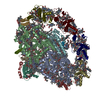
|
|---|---|
| 1 |
|
- Components
Components
-Photosystem I P700 chlorophyll a apoprotein ... , 2 types, 2 molecules AB
| #1: Protein | Mass: 82313.422 Da / Num. of mol.: 1 / Source method: isolated from a natural source / Source: (natural)  Physcomitrium patens (plant) / References: UniProt: Q8MFA3, photosystem I Physcomitrium patens (plant) / References: UniProt: Q8MFA3, photosystem I |
|---|---|
| #2: Protein | Mass: 82316.547 Da / Num. of mol.: 1 / Source method: isolated from a natural source / Source: (natural)  Physcomitrium patens (plant) / References: UniProt: Q8MFA2, photosystem I Physcomitrium patens (plant) / References: UniProt: Q8MFA2, photosystem I |
-Protein , 6 types, 6 molecules CEFHKL
| #3: Protein | Mass: 8649.957 Da / Num. of mol.: 1 / Source method: isolated from a natural source / Source: (natural)  Physcomitrium patens (plant) / References: UniProt: Q6YXQ2, photosystem I Physcomitrium patens (plant) / References: UniProt: Q6YXQ2, photosystem I |
|---|---|
| #5: Protein | Mass: 6895.725 Da / Num. of mol.: 1 / Source method: isolated from a natural source / Source: (natural)  Physcomitrium patens (plant) / References: UniProt: A0A2K1IKE2 Physcomitrium patens (plant) / References: UniProt: A0A2K1IKE2 |
| #6: Protein | Mass: 17465.363 Da / Num. of mol.: 1 / Source method: isolated from a natural source / Source: (natural)  Physcomitrium patens (plant) / References: UniProt: A0A2K1J0L9 Physcomitrium patens (plant) / References: UniProt: A0A2K1J0L9 |
| #8: Protein | Mass: 9861.088 Da / Num. of mol.: 1 / Source method: isolated from a natural source / Source: (natural)  Physcomitrium patens (plant) / References: UniProt: A9SL09 Physcomitrium patens (plant) / References: UniProt: A9SL09 |
| #11: Protein | Mass: 7916.146 Da / Num. of mol.: 1 / Source method: isolated from a natural source / Source: (natural)  Physcomitrium patens (plant) / References: UniProt: A9SFV4, UniProt: A0A2K1KU02*PLUS Physcomitrium patens (plant) / References: UniProt: A9SFV4, UniProt: A0A2K1KU02*PLUS |
| #12: Protein | Mass: 16892.416 Da / Num. of mol.: 1 / Source method: isolated from a natural source / Source: (natural)  Physcomitrium patens (plant) / References: UniProt: A9S7M7, UniProt: A0A2K1IAD0*PLUS Physcomitrium patens (plant) / References: UniProt: A9S7M7, UniProt: A0A2K1IAD0*PLUS |
-Predicted protein ... , 2 types, 2 molecules DG
| #4: Protein | Mass: 15654.927 Da / Num. of mol.: 1 / Source method: isolated from a natural source / Source: (natural)  Physcomitrium patens (plant) / References: UniProt: A9SRC8, UniProt: A0A2K1JKF2*PLUS Physcomitrium patens (plant) / References: UniProt: A9SRC8, UniProt: A0A2K1JKF2*PLUS |
|---|---|
| #7: Protein | Mass: 10564.831 Da / Num. of mol.: 1 / Source method: isolated from a natural source / Source: (natural)  Physcomitrium patens (plant) / References: UniProt: A9SJ10, UniProt: A0A2K1JC42*PLUS Physcomitrium patens (plant) / References: UniProt: A9SJ10, UniProt: A0A2K1JC42*PLUS |
-Photosystem I reaction center subunit ... , 3 types, 3 molecules IJM
| #9: Protein/peptide | Mass: 3791.472 Da / Num. of mol.: 1 / Source method: isolated from a natural source / Source: (natural)  Physcomitrium patens (plant) / References: UniProt: Q6YXR3 Physcomitrium patens (plant) / References: UniProt: Q6YXR3 |
|---|---|
| #10: Protein/peptide | Mass: 4597.460 Da / Num. of mol.: 1 / Source method: isolated from a natural source / Source: (natural)  Physcomitrium patens (plant) / References: UniProt: Q6YXM2 Physcomitrium patens (plant) / References: UniProt: Q6YXM2 |
| #13: Protein/peptide | Mass: 3051.623 Da / Num. of mol.: 1 / Source method: isolated from a natural source / Source: (natural)  Physcomitrium patens (plant) / References: UniProt: Q6YXK4 Physcomitrium patens (plant) / References: UniProt: Q6YXK4 |
-Chlorophyll a-b binding protein, ... , 4 types, 4 molecules 2635
| #14: Protein | Mass: 22922.107 Da / Num. of mol.: 1 / Source method: isolated from a natural source / Source: (natural)  Physcomitrium patens (plant) / References: UniProt: A0A2K1K0C7 Physcomitrium patens (plant) / References: UniProt: A0A2K1K0C7 |
|---|---|
| #15: Protein | Mass: 20761.584 Da / Num. of mol.: 1 / Source method: isolated from a natural source / Source: (natural)  Physcomitrium patens (plant) / References: UniProt: A9T399, UniProt: A0A2K1JLZ3*PLUS Physcomitrium patens (plant) / References: UniProt: A9T399, UniProt: A0A2K1JLZ3*PLUS |
| #16: Protein | Mass: 23250.502 Da / Num. of mol.: 1 / Source method: isolated from a natural source / Source: (natural)  Physcomitrium patens (plant) / References: UniProt: A9TEM8, UniProt: A0A2K1IB10*PLUS Physcomitrium patens (plant) / References: UniProt: A9TEM8, UniProt: A0A2K1IB10*PLUS |
| #17: Protein | Mass: 22445.592 Da / Num. of mol.: 1 / Source method: isolated from a natural source / Source: (natural)  Physcomitrium patens (plant) / References: UniProt: A0A2K1KN29 Physcomitrium patens (plant) / References: UniProt: A0A2K1KN29 |
-Sugars , 1 types, 1 molecules 
| #23: Sugar | ChemComp-DGD / |
|---|
-Non-polymers , 9 types, 204 molecules 
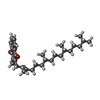




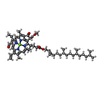
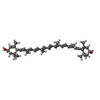
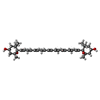








| #18: Chemical | ChemComp-CLA / #19: Chemical | #20: Chemical | ChemComp-LHG / #21: Chemical | ChemComp-BCR / #22: Chemical | #24: Chemical | #25: Chemical | ChemComp-CHL / #26: Chemical | ChemComp-LUT / ( #27: Chemical | ChemComp-XAT / ( |
|---|
-Details
| Has ligand of interest | N |
|---|---|
| Has protein modification | Y |
-Experimental details
-Experiment
| Experiment | Method: ELECTRON MICROSCOPY |
|---|---|
| EM experiment | Aggregation state: PARTICLE / 3D reconstruction method: single particle reconstruction |
- Sample preparation
Sample preparation
| Component | Name: PSI-LHCI / Type: COMPLEX / Source: NATURAL |
|---|---|
| Source (natural) | Organism:  Physcomitrella patens (plant) Physcomitrella patens (plant) |
| Buffer solution | pH: 7.4 |
| Specimen | Embedding applied: NO / Shadowing applied: NO / Staining applied: NO / Vitrification applied: NO |
- Electron microscopy imaging
Electron microscopy imaging
| Experimental equipment |  Model: Titan Krios / Image courtesy: FEI Company |
|---|---|
| Microscopy | Model: FEI TITAN KRIOS |
| Electron gun | Electron source:  FIELD EMISSION GUN / Accelerating voltage: 300 kV / Illumination mode: FLOOD BEAM FIELD EMISSION GUN / Accelerating voltage: 300 kV / Illumination mode: FLOOD BEAM |
| Electron lens | Mode: BRIGHT FIELD |
| Image recording | Electron dose: 50 e/Å2 / Film or detector model: GATAN K2 SUMMIT (4k x 4k) |
- Processing
Processing
| Software | Name: PHENIX / Version: 1.17.1_3660: / Classification: refinement | ||||||||||||||||||||||||||||||||
|---|---|---|---|---|---|---|---|---|---|---|---|---|---|---|---|---|---|---|---|---|---|---|---|---|---|---|---|---|---|---|---|---|---|
| EM software |
| ||||||||||||||||||||||||||||||||
| CTF correction | Type: NONE | ||||||||||||||||||||||||||||||||
| Symmetry | Point symmetry: C1 (asymmetric) | ||||||||||||||||||||||||||||||||
| 3D reconstruction | Resolution: 3.23 Å / Resolution method: FSC 0.143 CUT-OFF / Num. of particles: 70288 / Symmetry type: POINT | ||||||||||||||||||||||||||||||||
| Refinement | Highest resolution: 3.23 Å | ||||||||||||||||||||||||||||||||
| Refine LS restraints |
|
 Movie
Movie Controller
Controller





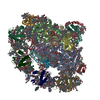

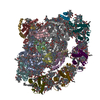
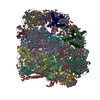
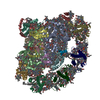

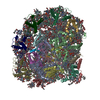
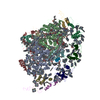
 PDBj
PDBj




















